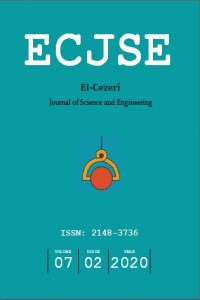Abstract
Enjeksiyon ile kalıplanmış plastiklerin üretim aşamasında soğutulması önemli bir yer tutmaktadır. Enjeksiyon kalıbındaki plastik malzeme düzgün ve yavaş bir şekilde soğutulursa üründe oluşabilecek çatlak ve gerilme riski en aza indirilmiş olur. Bu yüzden kalıp tasarlanırken soğutma kanallarının yeri, konumu ve özellikleri son derece önemlidir. Karmaşık geometrilere sahip kalıplarda deneysel çalışma ile optimum soğutma koşullarının tespit edilmesi mümkün değildir. Bu yüzden modelin simülasyonu hem maliyet hem de süre açısından önemlidir. Bu çalışmada soğutma kanallarının pürüzlülük katsayısı, soğutucu akışkanın debisi ve boru çapının kalıp içerisine enjekte edilmiş poliüretan kaplı araç direksiyonunun soğutulması üzerindeki etkisi simülasyon ile modellenerek incelenmiştir. Öncelikle farklı kalıp malzemelerinin, enjekte edilen plastiğin soğutulması üzerindeki etkisi araştırılmıştır. Çelik malzemesinden üretilen kalıp içerisinde bulunan plastiğin daha uzun sürede soğuduğu tespit edilmiştir. Daha sonra boru içerisinde yüzey pürüzlülük değerleri 0.045mm, 0.45mm ve 4.5mm, akışkanın debisi 4lt/dk, 8lt/dk ve 16lt/dk ve boru çapları 0.5cm, 1cm ve 1.5cm alınarak analizler yapılmıştır. Sonuç olarak pürüzlülük ve debinin artışı ile kalıbın daha kısa sürede soğuduğu görülmüştür. Ancak boru çapının artışı ile kalıbın daha geç soğuduğu gözlenmiştir.
References
- Mercado-Colmenero, J.M., Rubio-Paramio, M. A., Marquez-Sevillano, J.J., Martin-Doñate, C. A. “New method for the automated design of cooling systems in injection molds”, Computer-Aided Design, 2018, 104, 60–86.
- Turng, L.S., Wang, K.K. “A computer-aided cooling-line design system for injection molds”, J Eng Ind-Trans ASME, 1990, 112(2), 161–167.
- Opolski, S.W., Kwon, T.W. “Injection molding cooling system design”, In: ANTEC’86, 1987, 264–268.
- Li, C.L. “A feature-based approach to injection mould cooling system design”, Comput. Aided Des., 2001, 33(14),1073–1090.
- Li, C.L., Li, C.G., Mok, A.C.K. “Automatic layout design of plastic injection mould cooling system”, Comput. Aided Des., 2005, 37(7), 645–662.
- Guan, B., Cherrill, M., Pai, J.H., Priest, C. “Effect of mould roughness on injection moulded poly (methyl methacrylate) surfaces: Roughness and wettability”, Journal of Manufacturing Processes, 2019, 48, 313–319.
- Ronkay, F., Molnar, B., Dogossy, G. “The effect of mold temperature on chemical foaming of injection molded recycled polyethylene-terephthalate” Thermochimica Acta, 2017, 651, 65–72.
- Churchill, S.W. “Friction factor equations span all fluid-flow regimes”, Chem. Eng., 1997, 84(24), 91-92.
- Comsol Multiphysics 5.3. “Pipe Flow Module User’s Guide”, Heat Transfer Module, 2020. Incropera, F.P., DeWitt, D.P. “Fundamentals of Heat and Mass Transfer”, 5th ed., John Wiley & Sons, 2002, 486–487.
- McAdams, W.H., “Heat Transmission”, 3rd ed., McGraw-Hill, Bölüm 7, 1954, New York.
Abstract
The cooling of injection-molded plastics during production is of great importance. If the plastic material in the injection mold is cooled properly and slowly, the risk of cracking and stretching in the product is minimized. Therefore, the location, position and characteristics of the cooling channels are extremely important when designing the mold. It is not possible to determine the optimum cooling conditions by experimental study on molds with complex geometries. Therefore, the simulation of the model is important in terms of both cost and time. In this study, the effect of the roughness coefficient of the cooling channels, the flow rate of the refrigerant and the diameter of the channel on the cooling of the steering wheel of the polyurethane coated vehicle injected into the mold were modeled by simulation. First of all, the effect of different mold materials on the cooling of the injected plastic was investigated. It was determined that the plastic in the mold made of steel material was found to cool down in a longer time. Then the surface roughness values in the channel 0.045mm, 0.45mm and 4.5mm, flow rate of 4lt/min, 8lt/min and 16lt/min and channel diameters 0.5cm, 1cm and 2cm were analyzed. As a result, cooling time was decreased by 24.2% when the channel diameter was decreased by 75%, and decreased by 64.6% when the flow rate quadrupled.
References
- Mercado-Colmenero, J.M., Rubio-Paramio, M. A., Marquez-Sevillano, J.J., Martin-Doñate, C. A. “New method for the automated design of cooling systems in injection molds”, Computer-Aided Design, 2018, 104, 60–86.
- Turng, L.S., Wang, K.K. “A computer-aided cooling-line design system for injection molds”, J Eng Ind-Trans ASME, 1990, 112(2), 161–167.
- Opolski, S.W., Kwon, T.W. “Injection molding cooling system design”, In: ANTEC’86, 1987, 264–268.
- Li, C.L. “A feature-based approach to injection mould cooling system design”, Comput. Aided Des., 2001, 33(14),1073–1090.
- Li, C.L., Li, C.G., Mok, A.C.K. “Automatic layout design of plastic injection mould cooling system”, Comput. Aided Des., 2005, 37(7), 645–662.
- Guan, B., Cherrill, M., Pai, J.H., Priest, C. “Effect of mould roughness on injection moulded poly (methyl methacrylate) surfaces: Roughness and wettability”, Journal of Manufacturing Processes, 2019, 48, 313–319.
- Ronkay, F., Molnar, B., Dogossy, G. “The effect of mold temperature on chemical foaming of injection molded recycled polyethylene-terephthalate” Thermochimica Acta, 2017, 651, 65–72.
- Churchill, S.W. “Friction factor equations span all fluid-flow regimes”, Chem. Eng., 1997, 84(24), 91-92.
- Comsol Multiphysics 5.3. “Pipe Flow Module User’s Guide”, Heat Transfer Module, 2020. Incropera, F.P., DeWitt, D.P. “Fundamentals of Heat and Mass Transfer”, 5th ed., John Wiley & Sons, 2002, 486–487.
- McAdams, W.H., “Heat Transmission”, 3rd ed., McGraw-Hill, Bölüm 7, 1954, New York.
Details
| Primary Language | Turkish |
|---|---|
| Subjects | Engineering |
| Journal Section | Makaleler |
| Authors | |
| Publication Date | May 31, 2020 |
| Submission Date | January 29, 2020 |
| Acceptance Date | May 14, 2020 |
| Published in Issue | Year 2020 Volume: 7 Issue: 2 |
Cited By
Enjeksiyon Edilmiş Plastiğin Soğutulması İşleminin Optimizasyon Çalışması
European Journal of Science and Technology
https://doi.org/10.31590/ejosat.1010170



